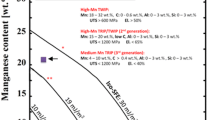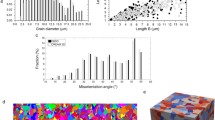Abstract
The effect of compression–tension loading on the microstructure evolution in a fully annealed Fe–24Mn–3Al–2Si–1Ni–0.06C twinning-induced plasticity steel has been investigated. Electron back-scattering diffraction was used to track a region of interest at true strains of 0 (initial), − 0.09 (after forward compression loading), and 0.04 (after reverse tension loading). All deformation twins detected after forward compression loading were found to de-twin upon subsequent reverse tension loading, likely due to the reverse glide of partial dislocations bounding the twins. The reverse loading behavior, including the twinning and de-twinning processes, was successfully simulated using a recently modified dislocation-based hardening model embedded in the visco-plastic self-consistent polycrystal framework, taking into account the dislocation accumulation/annihilation, as well as the twin barrier and back-stress effects.





Similar content being viewed by others
Notes
Some of the in-grain striations formed during compression disappeared upon reverse tension loading, while some remain and could still be seen in Fig. 3c. However, due to the uncertainty of the nature of these in-grain striations, any further discussion of their evolution upon reverse loading would be highly speculative.
The over-prediction during the initial stage of reverse tension loading could be improved by adjusting the dislocation recombination parameters (see Section 3.1 in Ref. 7), which dictates the dislocation annihilation rate (and hence the hardening), as the reversible dislocations generated during forward loading progressively recombine upon load reversal. However, such adjustment would defeat our purpose of using the same model parameters as in Ref. 7 and therefore was not undertaken.
References
O. Grassel, L. Kruger, G. Frommeyer, and L.W. Meyer, Int. J. Plasticity 16, 1391 (2000).
T.S. Byun, Acta Mater. 51, 3063 (2003).
D. Barbier, N. Grey, S. Allain, N. Bozzolo, and M. Humbert, Mater. Sci. Eng. A 500, 196 (2009).
A.A. Saleh, E.V. Pereloma, and A.A. Gazder, Acta Mater. 61, 2671 (2013).
A.A. Saleh, E.V. Pereloma, B. Clausen, D.W. Brown, C.N. Tomé, and A.A. Gazder, Acta Mater. 61, 5247 (2013).
A.A. Saleh, B. Clausen, D.W. Brown, E.V. Pereloma, C.H.J. Davies, C.N. Tomé, and A.A. Gazder, Mater. Lett. 182, 294 (2016).
S.J. McCormack, W. Wen, E.V. Pereloma, C.N. Tomé, A.A. Gazder, and A.A. Saleh, Acta Mater. 156, 172 (2018).
R.A. Lebensohn and C.N. Tomé, Acta Metall. Mater. 41, 2611 (1993).
R.A. Lebensohn, C.N. Tomé, and P.P. Castañeda, Philos. Mag. 87, 4287 (2007).
E.F. Rauch, J.J. Gracio, F. Barlat, and G. Vincze, Modell. Simul. Mater. Sci. Eng. 19, 035009 (2011).
K. Kitayama, C.N. Tomé, E.F. Rauch, J.J. Gracio, and F. Barlat, Int. J. Plasticity 46, 54 (2013).
W. Wen, M. Borodachenkova, C.N. Tomé, G. Vincze, E.F. Rauch, F. Barlat, and J.J. Grácio, Int. J. Plasticity 73, 171 (2015).
W. Wen, M. Borodachenkova, C.N. Tomé, G. Vincze, E.F. Rauch, F. Barlat, and J.J. Grácio, Acta Mater. 111, 305 (2016).
G. Palumbo and K. Aust, Acta Metall. Mater. 38, 2343 (1990).
W.F. Hosford and T.J. Allen, Metall. Trans. 4, 1424 (1973).
G.Y. Chin, W.L. Mammel, and M.T. Dolan, Trans. Metall. Soc. AlME 245, 383 (1969).
A.A. Gazder, A.A. Saleh, A.G. Kostryzhev, and E.V. Pereloma, Mater. Today Proc. 2, S647 (2015).
G. Proust, G.C. Kaschner, I.J. Beyerlein, B. Clausen, D.W. Brown, R.J. McCabe, and C.N. Tomé, Exp. Mech. 50, 125 (2010).
D. Sarker and D.L. Chen, Scr. Mater. 67, 165 (2012).
H. Wang, P.D. Wu, C.N. Tomé, and J. Wang, Mater. Sci. Eng. A 555, 93 (2012).
H. Wang, P.D. Wu, J. Wang, and C.N. Tomé, Int. J. Plasticity 49, 36 (2013).
L. Wu, S.R. Agnew, D.W. Brown, G.M. Stoica, B. Clausen, A. Jain, D.E. Fielden, and P.K. Liaw, Acta Mater. 56, 3699 (2008).
M.S. Szczerba, S. Kopacz, and M.J. Szczerba, Acta Mater. 60, 6413 (2012).
S. Hu, C.H. Henager Jr., and L. Chen, Acta Mater. 58, 6554 (2010).
T. Leffers and R.K. Ray, Prog. Mater. Sci. 54, 351 (2009).
A.A. Saleh, E.V. Pereloma, B. Clausen, D.W. Brown, C.N. Tomé, and A.A. Gazder, Mater. Sci. Eng. A 589, 66 (2014).
O. Bouaziz, S. Allain, and C. Scott, Scr. Mater. 58, 484 (2008).
Acknowledgements
This work was funded by the Australian Research Council—Discovery Projects DP130101882 and DP170100836. The authors thank Prof. D. B. Santos (UFMG, Brazil) for providing the source material and Mr. Heiko Tysar (BlueScope Steel Limited) for his help with the mechanical testing. C.N.T. was fully supported by the US DOE Project FWP 06SCPE401 under US DOE Contract W-7405-ENG-36. The JEOL JSM-7001F FEG-SEM was funded by the Australian Research Council—Linkage Infrastructure, Equipment and Facilities Grant LE0882613.
Author information
Authors and Affiliations
Corresponding author
Additional information
Publisher's Note
Springer Nature remains neutral with regard to jurisdictional claims in published maps and institutional affiliations.
Rights and permissions
About this article
Cite this article
Saleh, A.A., Wen, W., Pereloma, E.V. et al. Experimental and Self-Consistent Modeling Study of De-twinning in a Twinning-Induced Plasticity Steel. JOM 71, 1396–1403 (2019). https://doi.org/10.1007/s11837-019-03374-2
Received:
Accepted:
Published:
Issue Date:
DOI: https://doi.org/10.1007/s11837-019-03374-2




